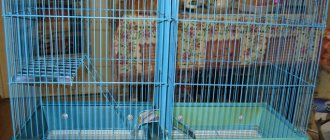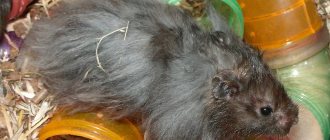Does a hamster need drinking water?
There is an opinion that hamsters are content with the liquid contained in vegetables and fruits. Some people conclude that a hamster does not need water at all. For what? Hamsters, as you know, live in the desert and make do with the water contained in their food. And the fact that dew falls every night in the desert and persists until sunrise is completely ignored by such advisers, just as the fact that there is no dew in a cage. So the animal needs to be given water, in addition to food, and you should not give the hamster super-properties; this warm-blooded land animal needs to drink.
Therefore, hamsters drink water; they must be provided with a fresh supply on an ongoing basis. You need to keep an eye on the drinking bowl, especially if water is given once every 2-3 days, or so that a situation does not arise when the drinking bowl malfunctions and leaks, and the animal begins to suffer.
Strictly speaking, it is better to give hamsters a drink every day, for example, after cleaning the cage - this way you can easily control the drinking bowl itself, and microbes that can cause inflammatory diseases in your pet will not begin to multiply directly in the water.
Bowl or sippy cup?
The daily drinking rate for a healthy rodent is 5-15 ml of water per 100 g of body weight . Using a bowl can cause constant tipping and puddles inside the cage. Litter, feces and food can also spoil the taste of the water if you use the bowl as a reservoir. The optimal solution for the animal is a water bottle.
A drinking bowl attached to the walls of the enclosure saves space and easily trains the animal to drink. When you press the valve or ball at the end of the spout, water drips into the rodent's oral cavity. Most animals determine the source of moisture themselves, but sometimes help is required. Just splash a drop of water on your pet's nose.
Important! To ensure uninterrupted access to liquid for the rodent, the water in the drinking bowl should be replaced daily, and in the summer, 2-3 times a day.
Water container and daily dosage
A hamster needs easily accessible water. For this, a special drinking bowl or bowl is used. Any container is sold in pet stores and is presented in an assortment. The option with a bowl is not the best; the animal can easily pollute its water by throwing pieces of bedding in there or even turning it over. Then the floor in the cage will get wet, and the homa himself will not be able to drink.
Since the choice of special drinkers is large, it is more convenient to choose the option with a dispenser.
The daily dose depends on the breed and size of the hamster. And also on the microclimate in the apartment - how hot and dry it is in the house. It is generally accepted that these rodents require 10 milliliters of water per 100 grams of weight. This is 2 teaspoons.
Milk: good or bad?
Wanting to diversify the diet, many owners treat hamsters with milk. Experts say that pregnant and lactating females should be fed dairy products . During the period of gestation and feeding, the body gives off energy and requires renewal.
4-5 grams of dissolved milk powder should be given for the first three weeks after the birth of the cubs.
If the mother dies, newborn hamsters are hand-fed with infant formula. Also, support with milk is needed for individuals who have suffered from the disease .
It is recommended to give milk to healthy and active animals no more than once a week as a reward or treat:
- It is advisable to choose milk with a minimum percentage of fat content.
- Before serving, the dairy product must be boiled and cooled for better digestibility.
- Cream, kefir, butter and cottage cheese with a high percentage of fat should be completely excluded from the diet. Products with a high proportion of fat content aggravate stomach and liver diseases.
Article on the topic: Can hamsters eat a pear (Syrian, Dzungarian and other breeds)
What kind of water can you give your hamster?
There are also discussions on this topic - whether you can drink from a tap or not, whether you need to freeze water and the like, which in itself is already surprising. A simple and reliable way is to drink clean water from a cooler or buy bottled water in a store. Half a liter bottle of water will last the animal for more than a month.
Questionable choice
Making a bad choice when deciding what water to give is choosing the tap option. Everyone knows that such water contains a lot of chlorine and other chemical compounds. This is easy to verify if you leave the water to settle. Within about a day, flakes and a suspension of settled contaminants will appear at the bottom of the vessel in which the water settles.
Sometimes there are recommendations to freeze tap water, and then defrost and drink this water. But such advice is similar to misconception, because if freezing kills microbes, then heavy chemical suspensions will not go away. And there are no microbes in tap water as such after chlorine.
Optimal choice
Therefore, the animal needs to be given clean water from a cooler or store. Another option is boiled water, and it is also allowed to stand for a day or longer. But considering how little water hamsters drink, it is still better to buy a bottle of regular purified water and add it to the drinking bowl. The water, of course, must be still.
When is swimming appropriate?
Despite the fact that water procedures are harmful to the baby, there are situations when bathing cannot be avoided:
- Your pet has gotten dirty with food. For example, if a baby gets into honey or mayonnaise or other similar products, the baby can lick this contamination from the fur on his own, but this can cause an upset stomach or even poisoning.
- Contamination of fur with household chemicals. If chemicals come into contact with your pet's fur, you should immediately rinse the coat with water.
- The appearance of fleas and ticks. This is a very rare occurrence, but very unpleasant. In this case, you need to wash the baby with a special shampoo.
You need to understand that sometimes it is not so easy to wash a hamster, but in no case do not forget about the rules of such procedures and it is important to always dry the fur.
Dehydration: causes and symptoms
A hamster is very vulnerable to dehydration and will not survive more than a day or two on dry food alone. Here the question of whether hamsters need water is excluded. Dehydration can occur in several situations:
- Khoma worked hard in the wheel, and then he ran out of water;
- the animal is sick, its stomach is upset and there is diarrhea, then dehydration can occur, despite a full drinking bowl;
- the hamster escaped from the cage and wandered around the apartment, in which case he is also at risk of dehydration;
- the animal may get sick and stop drinking;
- your pet may have suffered heatstroke.
In any case, dehydration develops very quickly and can be fatal if the situation is not corrected.
Description of the animal
Appearance
Djungarian hamsters weigh only 45 grams, and their body length does not exceed 10 cm. The animals have a predominantly brownish-gray back color with a lighter tummy color. Today you can find babies with more unusual colors: gray-lilac with a white belly, cream, matte white.
A distinctive feature of Djungarian hamsters is the dark stripe on their back.
The rodent has a pointed muzzle and small ears. There is a tail, but it is almost invisible. The feet are covered with hairs.
Even if there is enough food in the cage, the dwarf will definitely make a supply, putting goodies on his chubby cheeks.
One of the owners said that for some reason the pet even put a metal nut that he found in the house behind his cheek and then for a long time could not lift his head off the floor, which alarmed the whole family.
Lifestyle
Djungarian hamsters are nocturnal animals. Their activity awakens with the onset of dusk. But during daylight hours, they will take a nap with great pleasure in a cozy house or on the owner’s lap.
It is better to place the cage in a quiet corner so that the animal can rest peacefully during the day. But at the same time, it is better to place it away from the bedroom so that night noise does not disturb people’s light sleep.
In the descriptions of the animals there is information that the babies are very active and nimble. Active rodents need to be held firmly to prevent them from falling.
Hamsters are animals that are very unstable to stressful circumstances. Frightened, falling or experiencing pain, the baby may show aggression and even bite. And he will lose trust in the person.
The agile animal loves to climb up and down. If his house has special equipment, he will happily tumble there, but he will also never miss the opportunity to explore a person, climbing on him like a tree.
Photo: https://pixabay.com/photos/hamster-rodent-cage-pet-muzzles-2724477/
The rodents perform all their tricks with such positivity and optimism that it’s simply impossible to watch them without smiling.
But it wasn’t just his cute face that helped the hamster gain popularity. The absence of an unpleasant odor and the baby’s cleanliness are the main advantages of this rodent.
How long does a dzhungarik live?
When getting a rodent, people often wonder: how long do jungarians live at home?
Having naturally good health, the kids will be able to delight their owners with their company for three years. Naturally, if they receive proper care, a balanced diet and the absence of stress.
How to spot the symptoms of dehydration
Symptoms of dehydration are easy to notice if you look closely:
- the homa will have sunken eyes;
- dry mucous membranes;
- the animal will be weak and lethargic;
- there may be difficulty breathing.
And in addition to the listed signs, the skin will become loose. The skin test is the fastest way to determine dehydration. You need to pinch and slightly pull the skin on the hamster's neck. If the skin immediately returns to its previous position, then everything is fine. If the skin lingers even for a short time in a raised position, the animal is dehydrated.
Hand training
After acquisition, the animal must adapt to new conditions. During the first week, it is not recommended to touch the rodent or try to pick it up. Violent actions destroy the trusting relationship between pet and owner. You can get to know each other later, when the animal is ready to come out of hiding without fear when a person appears.
To pick up an animal, place a treat on your open palm and offer it to the hamster. If he ran into the house, there is no need to continue contact with him. You need to be patient.
IMPORTANT. It is forbidden to grab the hamster from behind or from above. In the wild, they are attacked by predators this way, so the rodent may instinctively bite or become very frightened.
When the rodent gets used to it a little and begins to climb onto your hand without fear in the cage, you can try to carry it in your hands through the door. In this case, you should hold your palm with a boat and monitor the pet’s behavior. He may suddenly run. If a rodent falls from a height, it will get hurt.
Hamsters love corn
Hamster rehydration
If your pet is slightly dehydrated because he ran out of his cage for a few hours, you need to take care of the problem by refilling the water bottle so that he drinks as much as he wants.
You should not try to bathe your pet thinking that this will quickly restore it. Hamsters do not swim in nature. Bathing will be stressful for the animal, and it may catch a cold.
When you suspect your pet is severely dehydrated or you don't know how long he's been without water, it's best to contact your veterinarian. Indeed, in some diseases, especially with diarrhea, it is not the disease itself that quickly kills, but possible dehydration.
The veterinarian will administer a saline solution with salt and mineral supplements intravenously or subcutaneously to help restore the condition.
Why does a rodent drink a lot of liquid?
If your pet's need for water has sharply increased, and the hamster begins to drink a lot of liquid, then you need to think about a change in behavior.
- Changes in temperature and humidity in the room. The ideal temperature is considered to be up to +22 degrees. For favorable wakefulness, it is better to move the cage with the animal to a cool place.
- Damage to the drinking bowl. It is necessary to check the connections for integrity and replace them in case of leaks.
- Changing the diet or quickly introducing a new food. It is advisable to switch to a new type of food gradually. Adding salty foods can also be a source of thirst.
If there are no changes in the activity of the rodent, then the appearance of kidney disease and the development of diabetes are possible . The main signs are:
- Eating more food.
- Rapid weight loss or obesity.
- The ruffled pose of the animal.
- Irritability and increased activity.
- Increased sleep duration.
- Frequent urine discharge, possibly with the smell of nail polish.
When your hamster drinks the weekly amount of water, you must show the animal to a doctor and begin a course of treatment.
Article on the topic: Can hamsters have raw and boiled potatoes?











